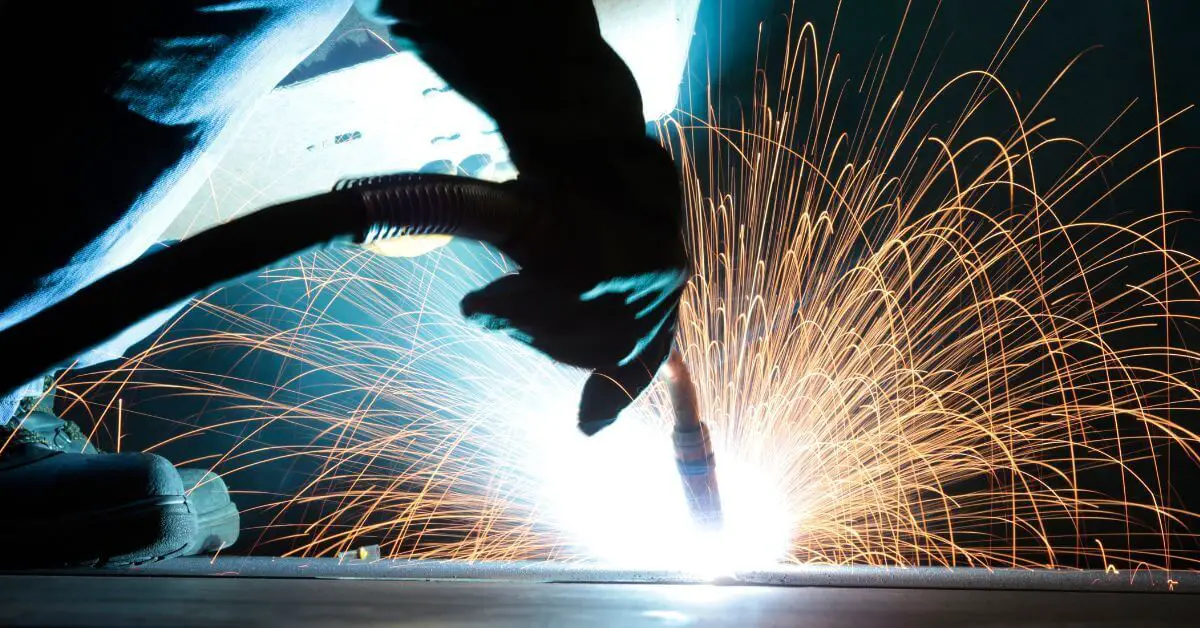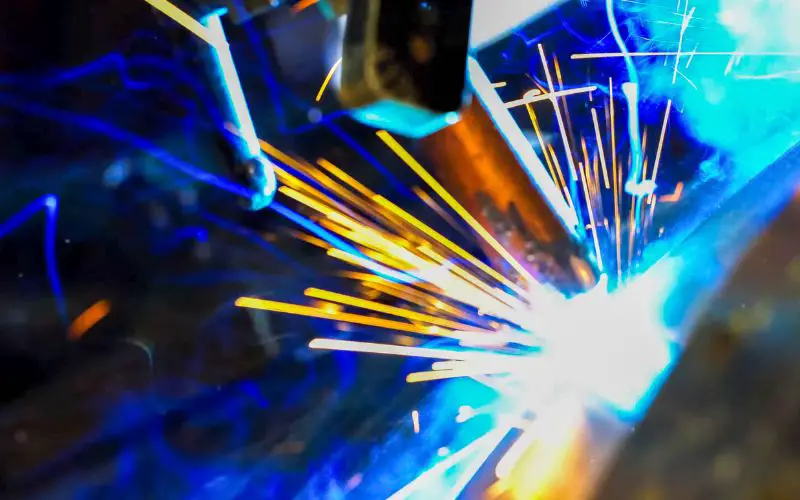Welding sparks are an integral part of the welding process, adding an element of both danger and beauty to the task at hand. These sparks are created when intense heat is applied to metal, causing it to melt and form droplets.
As these molten metal droplets fly through the air, they cool and solidify, resulting in what we commonly refer to as welding sparks or spatter.
This article will shed light on the potential risks associated with welding sparks and the importance of implementing safety measures.
What Causes Welding Sparks?
Welding sparks are luminous particles emitted by the welding arc during the welding process. The welding arc, an electrical current roughly similar to a mini lightning bolt, is primarily responsible for producing these sparks.
The electric current from the power source heats the metal until it reaches a molten state. This extreme heat is one of the key factors that contributes to the formation of welding sparks.
During the welding process, the heat can escalate to levels beyond 5,000 degrees Fahrenheit. At such high temperatures, the metals used within the welding process begin to shed molten droplets or “sparks”.
In order to successfully weld two pieces of metal together, an enormously high temperature is required. This temperature is enough to cause the metal electrode within the welding torch, as well as the workpiece, to reach a boiling point. As a result, charged particles are released into the air, which further contributes to the emission of sparks.
Hazards of Welding Sparks
While welding sparks can appear mesmerizing, they carry hidden risks due to the extreme heat involved in the welding process. Here are some of the hazards associated with welding:
Fire Hazards
One of the significant dangers posed by welding sparks is their ability to ignite flammable materials, potentially causing disastrous fire incidents. Consequently, substances known to be combustible – such as oil, paint, gas, or dust – can rapidly ignite upon exposure to these sparks, making the work environment unsafe.
Burn Injuries
Welding sparks carry an intense heat that can lead to severe burn injuries if they come into contact with the skin or fire-prone clothing. The molten metal particles within the sparks can quickly burn through the fabric and damage the skin, leading to painful injuries that may require extensive recovery periods.
There are primarily two types of burns caused by welding sparks:
1. Body Burns occur when sparks make contact with the skin, causing burns of varying severity depending on the spark’s intensity and exposure duration.
2. Eye Burns: This happens when sparks or hot metal fragments penetrate the eyes. Eye burns can cause considerable pain, discomfort, and even potential vision loss.
UV Light Exposure
Another hazard associated with welding sparks is the emission of ultraviolet (UV) radiation which can harm our skin and eyes. There are three different types of UV rays – UVA, UVB, and UVC:
- UVA and UVB rays are commonly present in sunlight but can also be generated during welding.
- UVC rays, while typically filtered out in Earth’s atmosphere, can be produced in specialized welding procedures.
Extended exposure to these UV rays from welding sparks, without proper safety measures, can lead to conditions like arc eye or welder’s flash. This can result in intense pain, temporary or long-term vision impairment, and, at worst, blindness.
Arc Eye and Photokeratitis
Arc eye, also termed as welder’s flash or flash burns, is a common consequence of prolonged exposure to the UV radiation emitted by welding sparks. This condition resembles the sunburn effect but affects the eye’s cornea. The symptoms of arc eye range from pain, redness, and excessive tearing to short-term blindness, light sensitivity, and a gritty sensation in the eyes.
Safety Considerations and Precautions When Working with Sparks and Flames
1. Utilize Personal Protective Equipment (PPE)
Welding process generates temperatures over 5,000 degrees Fahrenheit demands reliable safeguarding measures. Hence, the use of Personal Protective Equipment (PPE) is essential.
- Welding Helmet: An indispensable piece of safety equipment for welders is the welding helmet. This protective gear shields the face and eyes from the intense light of the welding arc and the flying sparks and debris produced during the welding process.
- Safety Goggles: Safety goggles are essential to guard against potential impacts and damage to the eyes to augment the helmet’s safety.
- Flame-Resistant Jackets: Flame-resistant jackets provide a crucial barrier between a welder’s skin and hot metal, significantly reducing the possibility of severe burn injuries.
- Heavy-Duty Gloves: Protective gloves from fire-resistant material shield the hands against direct exposure to sparks and molten metal.
- Sturdy Leather Boots: To round off the safety gear list, a pair of robust leather boots offer protection from potential fire hazards and sharp objects on the workplace floor.
2. Ensure Adequate Ventilation
The welding workspace must be well-ventilated to efficiently dispel welding fumes and lower the risk of respiratory complications.
3. Maintain Safe Distances
Keeping a substantial gap between the welding operations and any flammable or combustible material is a critical safety tenet to follow.
4. Prioritize Fire Prevention Measures
Having a fire extinguisher at hand plays a crucial part in welding safety. Keeping the workspace clutter-free and clear of flammable substances also aids significantly in preventing potential fire accidents.
5. Pursue Professional Training and Adhere to Safety Guidelines
Undergoing proper training can empower welders to work more safely and efficiently. Adhering to safety guidelines established by industry experts is another critical step in minimizing the risks associated with welding sparks.
How To Reduce Welding Spark & Promote a Safer Working Environment?
Implementing appropriate measures can help reduce welding sparks and promote a safer working environment. Here are five ways to achieve this:
1. Optimize the Welding Process
A critical method to reduce welding sparks involves adjusting the welding process itself. By modifying settings such as voltage and wire speed, the formation of sparks can be minimized significantly. Further options include employing pulse welding techniques or shortening the welding arc length.
2. Cleanliness and Workspace Organization
Ensuring a clean workspace devoid of flammable or combustible material is pivotal in decreasing the likelihood of sparks igniting fires. Regularly tidying up the work area and maintaining proper ventilation enhances overall safety.
3. Using Welding Curtains or Screens
Welding curtains or screens provides a physical barrier containing sparks within the immediate work area. Typically made from fire-resistant material, these barriers can be strategically placed around the welding operation to prevent sparks from escaping.
4. Invest in Fire-Resistant Coatings or Materials
Protecting flammable surfaces in the surrounding area with fire-resistant coatings or materials can help mitigate the risks associated with sparks. Options such as fire-retardant spray-on coatings or fire-resistant blankets provide additional protection against sparks, consequently minimizing the potential for fire hazards.
5. Consider Tungsten Inert Gas (TIG) Welding
Different welding methods and technologies yield varying results in terms of sparks and spatter. Metal Inert Gas (MIG) welding, a popular choice, uses a welding gun with a metal electrode to create an arc that joins metals. However, Tungsten Inert Gas welding has become increasingly favored due to its advantages in reducing spatter and improving overall welding outcomes.
Distinct from MIG welding, TIG welding employs a tungsten electrode rather than a metal one to create an arc. This mitigates the risk of spatter and spark production, commonly associated with MIG welding.
Conclusion
The mesmerizing display of welding sparks belies the potential hazards they pose. To mitigate these risks, welders must prioritize safety measures, don the right protective gear, and practice vigilant safety routines.
This vigilance, combined with knowledge, will help prevent fire incidents, severe burn injuries, and the damaging effects of ultraviolet (UV) light exposure. Always ensure a safe welding environment to neutralize the perils associated with the captivating spectacle of welding sparks.








